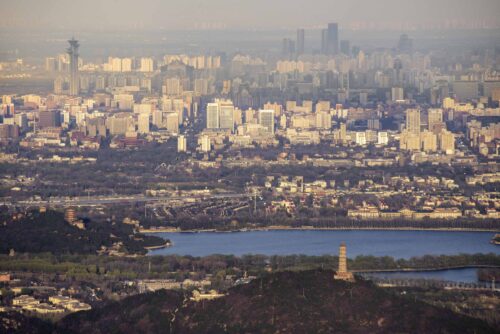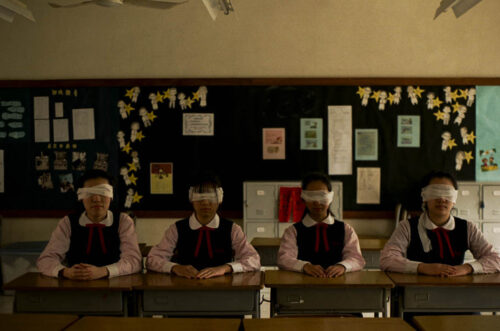The Big Picture: The eco-conscious photography of Duzi

“Science can help us understand the facts, but art communicates them in a way that gets people really talking.”
The 2017 Lishui Photography Festival 丽水摄影节 in Zhejiang Province was held in November with the kind of razzmatazz one has come to expect from a large-scale Chinese event bearing the official seal. Festivities began with the obligatory opening ceremony comprising predictable song-and-dance routines punctuated by vaguely jingoistic speeches from local honchos. The pomp set the tone for a festival gigantic in scale: More than 1,500 exhibitions infiltrated all quarters of Lishui 丽水, from North American exhibitions curated by New Yorker Jim Ramer to community photography projects peppering the alleyways of the old town. Legions of volunteers equipped with high-school English were on hand to point lost festival attendees in the right direction, while public buses were free, ensuring visitors could get from photo seminar to workshop to bar with as little bother as a third-tier Chinese city might otherwise cause.
This mammoth effort was part of Lishui’s aim to cast off its image as the ragtag industrial town documented in dispatches by Peter Hessler almost a decade ago. This historic, prefecture-level city — whose name literally means “Beautiful Water,” earned during the Tang dynasty — eschews heavy industry in favor of developing culture and tourism these days, according to those I spoke with in the organizing committee. Lishui even landed a “Chinese Town of Photography” designation from the China Photographers Association 中国摄影家协会 in 1999.
More than 5,000 photographic works tackled the subject of “the image in the age of hypermedia,” and overall, it was enticing. But behind the spectacle, there was, alas, much mediocrity. The experience was much like sifting through a textile bazaar in Dongguan or Wuxi — buried somewhere is something worthwhile, you just have to rummage and know where to look.
On the advice of art critic Bao Kun 鲍昆, I realized Lishui’s more divisive and intriguing work was to be found in a discreet locale up in the hills that frame the city, where a Mao-era oil pumping facility had been repurposed as a gallery space. Strolling the aisles of the factory-turned-expo, I stumbled upon a solo exhibition worth writing home about — Marine Reclamation 填海, by Beijing-based photographer Duzi 杜子, a startling look at environmental degradation in the name of development.

I’d last encountered Duzi in 2013 at the prestigious Lianzhou Foto Festival 连州国际摄影年展 in Guangdong Province, where his series Scar 瘢痕 was being exhibited. That year, Duzi had just won the coveted Jury Award at China’s other great photographic shindig, in Pingyao, and was duly drawing much attention.
As someone who spends much of his time stumbling around East Asian art gatherings, I find it easy to forget about a particular exhibition. But Duzi’s images were too powerful, alarming, and, conversely, beautiful to slip from memory. Scar documents China’s massive industrial and urban projects, often in remote areas of the Central Plains and Northwest: mountains leveled to make way for new urban areas, pits and mines that have turned the earth inside out, industrial waste gathered in hill-sized mounds. Duzi pairs his eye-level photographs with satellite images from Google Earth, providing a multitiered perspective of how human activity is reshaping the planet.
Although he runs in artistic circles, it’s no surprise that Duzi’s career included a long apprenticeship in photojournalism. “I graduated from Wuhan University, where I majored in photography,” the artist explains over tea in his adopted home in Songzhuang Art Colony, a village on the edges of Beijing. “Then, in 1991, I went directly to work at [the press agency] People’s Photography 人民摄影报. I stayed there until 2004.”
This pioneering agency, which is published in Duzi’s home province of Shanxi, cultivated a generation of luminaries, people like Duan Yuting 段煜婷, Chang He 常河, Zhang Lihua 张莉华, and Xu Jing 徐静, who would come to dominate the Chinese photographic scene in the post-reform era as curators, critics, and artists in their own right.
While working as a freelance commercial photographer in the late 2000s, Duzi was struck with an existential crisis when he lost a few family members to cancer. “It changed my perspective,” he says. “I realized time was short and began to question what I was doing with my life and work, what was happening around me.”
He resolved to produce something of value, so he called upon his skills and experience gleaned from People’s Photography and turned to issues relating to the country’s development. He returned to his hometown of Taiyuan, a northern transport hub that exposed a part of China found outside of showcase cities and mainstream headlines.
“Look at this,” the artist tells me, pointing at one particular picture. “They destroyed 700 mountaintops to build a new city district in Gansu!”



In 2014, Duzi’s research led him from the interior to the coast, where he witnessed similarly destructive scenes along the water’s edge. This inspired his latest project, Marine Reclamation, which occupied the entire room of the factory, and included film footage to communicate Duzi’s view of the senseless coastal redevelopment and polluting activities along the seaboard.
He doesn’t mince words when he talks about the project: “What I document amounts to hysterical policies of land expansion built on the utopian fantasy of a prosperous future. Mass consumption, capital investment, and political power have also served as the fuels for this so-called development. I’ve seen extended seawalls and sandbags stretching like the Great Wall to the horizon, as large sections of wetlands and mangroves have become industrial development zones, ports, technological parks, vacation resorts, artificial beaches, and exotic ocean-view homes. Of course, among these, there are also half-constructed buildings and plenty of abandoned wasteland!”
To add transparency and authenticity to his work, Duzi used social media, capturing a WeChat location in each area he visited. He also began several conversations online. Both the locations and people’s comments are exhibited alongside his work.
As we watch a video of a pipe spewing untreated sewage into the sea, I wonder if he ever feels threatened or nervous about his approach.
“Laymen generally know what I’m saying, that the environment needs protecting,” he states. “And this kind of criticism is one that’s acceptable in China right now.”
China’s official green stance can often seem at odds with the view from the ground, but it has enabled Duzi to operate without too much hindrance — though his appearance at an exhibition was canceled during the 19th Party Congress in October, when, paradoxically, much noise was made about the need to protect the environment.
Contradicting the official picture can make life tricky for artists with an activist streak, but Duzi seems to recognize the boundaries, and he’s driven by his quest to document the shadowy side of China’s meteoric rise despite the risks.
“I plan to travel the whole coast next year. There are still many places I haven’t been, important things that need documenting,” he says. “You know, these are big issues and it’s important we keep the dialogue going. That’s why I use art. Science can help us understand the facts, but art communicates them in a way that gets people really talking.”




For more information, you can contact the artist: duziart@126.com.






